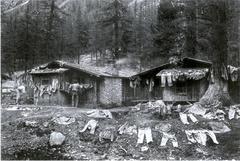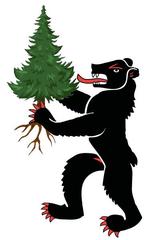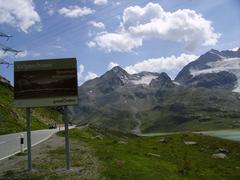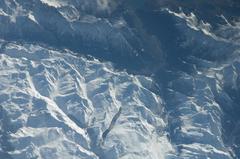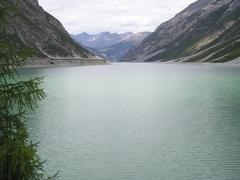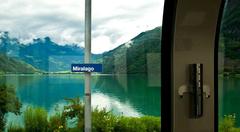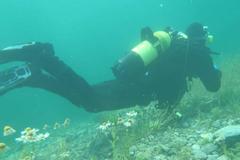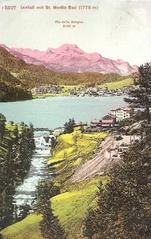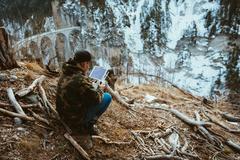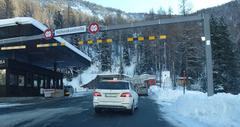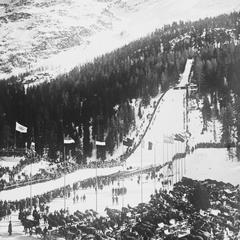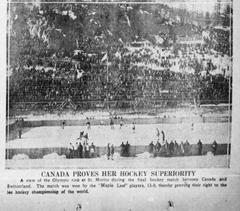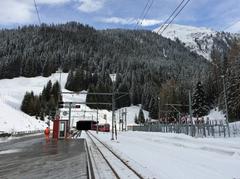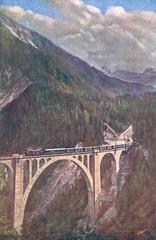
Crap Sogn Parcazi Visiting Hours, Tickets, and Travel Guide
Date: 04/07/2025
Introduction
Crap Sogn Parcazi, perched dramatically on a rocky outcrop near the village of Trin in the Surselva region of the Canton of Grisons (Graubünden), Switzerland, is a remarkable testament to the region’s layered history, architectural ingenuity, and enduring cultural significance. Named after the Romansh for “Rock of Saint Pancras,” this site weaves together the stories of Roman fortifications, medieval ecclesiastical power, and the resilient Romansh-speaking communities of the Alps. Today, visitors are invited to explore its atmospheric ruins, enjoy panoramic views, and connect with centuries of Alpine heritage—all with free year-round access.
This comprehensive guide details the historical background, practical visitor information (including visiting hours, ticketing, and accessibility), travel tips, and essential recommendations to help you make the most of your visit to Crap Sogn Parcazi (DHS; swisscastles.ch; Together in Switzerland; Trin Tourism Office; Trin Verkehrsverein).
Historical Overview
Early Settlement and Strategic Role
Crap Sogn Parcazi’s history begins in the late Roman period, with archaeological evidence indicating fortifications from the 4th and 5th centuries CE. Its rocky promontory offered a commanding view over the Vorderrhein valley, allowing for the control of vital transit and trade routes through the Alps—a strategic importance that continued through the Middle Ages.
Medieval Development and Ecclesiastical Authority
By the early Middle Ages, the site had transformed from a Roman outpost into a fortified ecclesiastical center. The earliest documentation dates to the 8th century, coinciding with the spread of Christianity in the region. The construction of a church dedicated to Saint Pancras (Sogn Parcazi) established the site as a spiritual anchor for surrounding communities. Over time, the complex was expanded, serving both as a residence for local nobility and clergy and as a defensive stronghold against regional turbulence (DHS).
Feudal Power and the Lords of Belmont
During the high medieval period, Crap Sogn Parcazi became the seat of the influential Lords of Belmont. They strengthened fortifications with a stone keep and curtain walls, asserting control over the valley and its trade. As both a military bastion and administrative center, the site played a critical role in the administration of justice and the collection of tolls. The Belmonts’ influence peaked in the 13th century, after which the site’s strategic importance waned (DHS).
Decline and Rediscovery
After the decline of the Belmont family in the late 14th century, Crap Sogn Parcazi was gradually abandoned. While the church continued to serve as a place of worship for some time, much of the complex fell into ruin. Systematic archaeological investigations in the 20th century revealed layers of Roman, medieval, and ecclesiastical structures, prompting restoration efforts to preserve the site for future generations (swisscastles.ch).
Architectural and Archaeological Highlights
- Stone Keep: The most prominent feature, dating from the 12th and 13th centuries, once served as the main defensive tower.
- Church Ruins: Foundations and partial walls of the early medieval church of Saint Pancras, with remnants of frescoes and liturgical artifacts.
- Curtain Walls and Domestic Structures: Remains of fortifications and residential quarters reflect the site’s multifaceted roles.
- Artifacts: Finds span from Roman pottery and early Christian graves to medieval weaponry, illustrating the site’s long and varied occupation.
Informational panels in German and Romansh—with some English—help visitors interpret the site’s features and history.
Cultural Significance
Crap Sogn Parcazi stands as a symbol of the Grisons’ complex heritage, reflecting the interplay of Roman, medieval, and modern influences. It is especially significant for the Romansh community, whose language and cultural traditions remain vibrant in the Surselva valley. The site not only underscores the region’s Christianization and feudal history but also embodies the resilience of minority cultures within Switzerland’s unique trilingual canton (Together in Switzerland).
Visitor Information
Visiting Hours
- Open: Year-round, from daylight to dusk (approximately 8:00 AM to sunset).
- Best Season: May to October, when weather and trail conditions are optimal.
Tickets and Admission
- Entry: Free of charge; no reservation or ticket required.
- Guided Tours: Available from June to September via the Trin Tourism Office; primarily in German and Romansh, with English upon request. Advance booking is recommended.
Accessibility
- Trail: 30-minute moderate hike from Trin-Porclis (bus stop/parking), with a final steep ascent using fixed cables. Not wheelchair accessible.
- Suitability: Best for visitors with basic fitness; not recommended for those with mobility issues or very young children.
Facilities
- On-site: No restrooms or refreshment stands; bring water and snacks.
- Nearby: Amenities available in Trin village.
Travel Directions
- By Car: Park at Trin or Trin-Porclis.
- By Public Transport: Bus from Chur to Trin, then follow signposted trail.
- Address: Crap Sogn Parcazi, 7014 Trin, Switzerland
Safety and Tips
- Wear sturdy hiking shoes and layered clothing.
- Check weather forecasts before visiting (Meteoblue).
- Dogs allowed on leash.
- Use fixed cables for the final ascent and supervise children closely.
Events and Cultural Activities
- Guided Tours: June–September, book via Trin Tourism Office.
- Cultural Events: Summer festival, open-air concerts, and historical reenactments celebrate local heritage.
- Educational Programs: For school groups and families, focusing on archaeology and Romansh culture.
Nearby Attractions
- Lake Cresta and Lake Cauma: Stunning mountain lakes nearby.
- Chur: Switzerland’s oldest city, with museums and a picturesque old town (Chur Tourism).
- Rhine Gorge (Ruinaulta): Known as the Swiss Grand Canyon, ideal for hiking and photography.
Frequently Asked Questions (FAQ)
Q: What are the opening hours?
A: Year-round, daylight hours (approx. 8:00 AM to sunset). Avoid visiting after dark.
Q: Is there an entrance fee or ticket required?
A: No, entry is free.
Q: Are guided tours available?
A: Yes, June–September, book in advance via the Trin Tourism Office.
Q: Is the site wheelchair accessible?
A: No, steep and uneven terrain.
Q: Are there restrooms on site?
A: No, use facilities in Trin village.
Q: Can I bring my dog?
A: Yes, but keep dogs on a leash.
Q: Is the trail suitable for children?
A: Suitable for children aged 8+ who are comfortable with moderate hiking and heights.
Practical Summary Table
| Aspect | Details |
|---|---|
| Elevation | 1,050 m above sea level |
| Access | 30-min hike from Trin-Porclis; steep final ascent with safety cables |
| Facilities | None on site; amenities in Trin |
| Best Season | May–October |
| Difficulty | Moderate; steep section at summit |
| Family Friendly | For older children (8+); not stroller/wheelchair accessible |
| Pets | Allowed on leash |
| Guided Tours | June–September; via Trin Tourism Office |
| Emergency | Dial 112; nearest hospital in Chur |
Sustainability and Conservation
Crap Sogn Parcazi is managed with a strong commitment to preservation and sustainable tourism. Visitors are asked to respect the archaeological environment, avoid climbing on fragile ruins, and support local businesses.
Visual Gallery
For more images, visit Wikimedia Commons Media Collection.
Plan Your Visit
To enhance your experience, download the Audiala app for audio guides, interactive maps, and up-to-date event information. Stay connected for updates and travel tips:
- Facebook: @GrisonsHeritage
- Instagram: @Grisons_Travel
- Twitter: @GrisonsTourism
For the latest information and visitor tips, consult the Grisons Tourism website, Surselva regional portal, and Trin Tourism Office.
Conclusion
Crap Sogn Parcazi stands as a powerful symbol of Grisons’ rich historical and cultural legacy. Its ruins, panoramic views, and accessibility make it a must-visit destination for anyone interested in Switzerland’s Alpine heritage. Plan your visit during the warmer months, prepare adequately for the hike, and immerse yourself in the stories that have shaped this extraordinary site.
Sources and Further Reading
- DHS: Crap Sogn Parcazi
- swisscastles.ch: Crap Sogn Parcazi
- Together in Switzerland: Graubünden’s Most Welcoming Region
- Trin Tourism Office
- Trin Verkehrsverein



